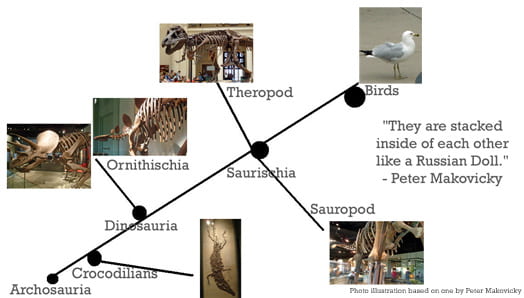WHY BIRDS ARE BIRDS: LOOKING AT DINOSAURS FOSSILS TO UNDERSTAND EVOLUTION
By: Hallie D. Martin
Dinosaurs are to birds as humans are to apes.
While that connection isn’t new, it helps scientists understand extinct animals, and tells them what that connection means in terms of evolution.
“The real story is that over the last 10 years, we’ve gotten to understand the macro evolutionary pattern,” said Peter Makovicky, associate curator of dinosaurs at the Field Museum. “And that’s just jargon for understanding how birds came to be, how bird anatomy and specialization systems were put together step-by-step through evolutions.”
The word “dinosaur” is Greek for “terrible lizard.” Scientists now know that dinosaurs are more closely related to birds than to reptiles, but early scientists, who began seriously studying paleontology in the mid-1800s, thought they were close to reptiles.
Things were thought of in classes back then, Makovicky said, and reptiles were a completely separate class from birds. Early scientists probably thought dinosaurs were closer to reptiles because animals like the Tyrannosaurus rex and the Triceratops don’t exactly look like chickens.
“They also thought crocodiles were reptiles because they look like reptiles, but they are actually more closely related to birds,” Makovicky said.
Scientists now have more of an evolutionary mindset.
“When we think of vertebrate classes, it’s a class system based on a notion of creation where everything arrived on one day and didn’t change,” said Jack Horner, professor of paleontology at Montana State University. “Now we know animals are related to each other.”
Dinosaurs, birds and crocodiles share a common ancestor, Archosauria.
Starting at the point of the common ancestor, the evolutionary line grows upwards, branching out at crocodilians (crocodiles and alligators).
Moving onward to dinosauria, the line branches out at Ornithischia dinosaurs (duck-billed dinosaurs, stegosauruses and triceratops are in this group).
Back on the Archosauria line, evolution branches out again at Saurischia dinosaurs, which fall into two groups, Sauropods, (like the long-necked Apatosaurus), and Therapods, meat-eating dinosaurs that walked on two legs (like the Tyrannosaurus rex).
The Archosauria line moves past dinosaurs and onto birds with many extinct forms in between.
“We can map out that transition in much more detail than we could 20 years ago,” Makovicky said.
Since the earliest dinosaurs, birds slowly acquired wishbones, feathers, flight, longer arms and some type of controlled body temperature. Dinosaurs became more and more bird-like until some of them actually became birds.

The evolutionary line of birds (Illustration by Hallie D. Martin, based on one by Peter Mackovicky)
Dinosaurs have in fact given rise to birds,” said Mike Henderson, curator of Earth science at the Burpee Museum in Rockford. “but we still have a long way to go about understanding diversity of birds.”
The Archaepteryx, an early dinosaur found fossilized with feathers in 1860, began the conversation about birds and dinosaurs being related.
Since then, scientists became convinced of the dinosaur-bird link by going through the scientific process: Coming up with a hypothesis, or conclusion, then proving it with data to see if it is true or false.
“In science we don’t ever know a 100 percent that something is true,” Horner said. “If we can’t falsify then that’s what we assume is true.”
So when it comes to the link between dinosaurs and birds, scientists made an educated guess by comparing skeletal structures to see what features dinosaurs shared with different animals.
“Characteristics that are shared by some evolutionary advanced animals are inherited from a common ancestor,” Makovicky said.
Take a look at the number of fingers dinosaurs have, he said. Ancestrally, dinosaurs had five fingers and as they went up through the evolutionary history for therapods, they lose their pinky, then fourth finger, ending up with three fingers.
The Tyrannosaurus rex is more advanced, it only has two fingers.
Scientists have also unearthed more and more dinosaur fossils indicating some dinosaurs were covered in some sort feathers like the Velocer raptor.
“Very early Tyrannosaurs had a feather-like structure,” Henderson said. “That evidence is not the only evidence that birds and dinosaurs are closely related.”
Recently, scientists were able to extract and sequence proteins out of a well-preserved T-Rex bone. They compared it to many other animals, and to no surprise they closely matched birds.
“There’s little doubt, and that wasn’t the case 10 years ago, that birds evolved from dinosaurs,” Henderson said.
